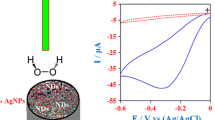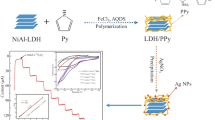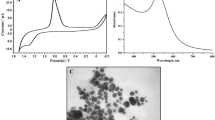Abstract
In this study, we report a new ratiometric electrochemical sensor to accurately and selectively detect hydrogen sulfide (H2S) in biological samples. In this system, it contains electroactive Ag dendritic nanocomposites (NCs) as a special recognition element of H2S and methylene blue (MB) as an inner reference molecular for a built-in correction to improve the accuracy. The Ag NCs are prepared and synthesized by a electrodeposition method, and the branches consist of rounded and smooth segments with a diameter of about 300 nm. In the presence of H2S, combining with the good adsorption ability of GO and more active sites of dendritic Ag nanostructure, the Ag NCs of GO/MB/Ag can be oxidized to Ag2S in the oxygen environment, resulting in the decrease of electrochemical oxidation peaks of Ag (0.42 V) and constant of current responses of MB. On the basis of the ratio of IAg/IMB at two distinct potentials, the developed ratiometric electrochemical sensor displays a wide linear range from 30 to 500 μM with high accuracy, selectivity, and stability. This strategy provides a reliable and feasible method for the detections of H2S in real samples, including biological samples related to physiological and pathological events of hydrogen sulfide production.

Graphical abstract








Similar content being viewed by others
References
Bo W, Liu ZF, Hong TT, Han JH, Guo KY, Zhang XQ, Chen D (2015) Trilaminar graphene/tremella-like CuInS2/graphene oxide nanofilms and the enhanced activity for photoelectrochemical water splitting. J Nanopart Res 17:295
Chen YC, Zhu CC, Yang ZH, Chen JJ, He YF, Jiao Y, He WJ, Qiu L, Cen JJ, Guo ZJ (2013) A ratiometric fluorescent probe for rapid detection of hydrogen sulfide in mitochondria. Angew Chem Int Ed 52:1688–1691
Chen CM, Xu J, Yao Y (2018a) Fabrication of miniaturized CSRR-loaded HMSIW humidity sensors with high sensitivity and ultra-low humidity hysteresis. Sensors Actuators B Chem 256:1100–1106
Chen ZC, Lai GS, Liu S, Yu AM (2018b) Ultrasensitive electrochemical aptasensing of kanamycin antibiotic by enzymatic signal amplification with a horseradish peroxidase-functionalized gold nanoprobe. Sensors Actuators B Chem 273:1762–1767
Dong H, Zhang LM, Liu W, Tian Y (2017) Label-free electrochemical biosensor for monitoring of chloride ion in an animal model of Alzheimer’s disease. ACS Chem Neurosci 8:339–346
Ghorbani-Bidkorbeh F (2015) Electrochemical sensors and biosensors represent very promising tools in pharmaceutical sciences. Iran J Pharm Res 14:663–664
Gibbons SJ, Verhulst PJ, Bharucha A, Farrugia G (2013) Review article: carbon monoxide in gastrointestinal physiology and its potential in therapeutics. Aliment Pharmacol Ther 38:689–702
Giuliani D, Ottani A, Zaffe D, Galantucci M, Strinati F, Lodi R, Guarini S (2013) Hydrogen sulfide slows down progression of experimental Alzheimer’s disease by targeting multiple pathophysiological mechanisms. Neurobiol Learn Mem 104:82–91
Govindhan M, Liu ZG, Chen AC (2016) Design and electrochemical study of platinum-based nanomaterials for sensitive detection of nitric oxide in biomedical applications. Nanomaterials-Basel 6
Hall JR, Schoenfisch MH (2018) Direct electrochemical sensing of hydrogen sulfide without sulfur poisoning. Anal Chem 90:5194–5200
Hao JR, Xiong B, Chen XD, He Y, Yeung ES (2014) High-throughput sulfide sensing with colorimetric analysis of single au-Ag core-shell nanoparticles. Anal Chem 86:4663–4667
Hartle MD, Pluth MD (2016) A practical guide to working with H2S at the interface of chemistry and biology. Chem Soc Rev 45:6108–6117
Hosoki R, Matsuki N, Kimura H (1997) The possible role of hydrogen sulfide as an endogenous smooth muscle relaxant in synergy with nitric oxide. Biochem Bioph Res Co 237:527–531
Iqbal MF, Ashiq MN, Razaq A, Saleem M, Parveen B, Hassan M-U (2018) Excellent electrochemical performance of graphene oxide based strontium sulfide nanorods for supercapacitor applications. Electrochim Acta 273:136–144
Kamoun P (2004) Endogenous production of hydrogen sulfide in mammals. Amino Acids 26:243–254
Koike S, Kawamura K, Kimura Y, Shibuya N, Kimura H, Ogasawara Y (2017) Analysis of endogenous H2S and H2Sn in mouse brain by high-performance liquid chromatography with fluorescence and tandem mass spectrometric detection. Free Radic Biol Med 113:355–362
Kuang Q, Xue N, Chen J, Shen ZY, Cui XM, Fang Y, Ding XQ (2018) Low plasma hydrogen sulfide is associated with impaired renal function and cardiac dysfunction. Am J Nephrol 47:361–371
Li HB, Li J, Zhu YY, Xie WY, Shao R, Yao XX, Gao AQ, Yin YD (2018) Cd2+-doped amorphous TiO2 hollow spheres for robust and ultrasensitive photoelectrochemical sensing of hydrogen sulfide. Anal Chem 90:5496–5502
Li Z, Jiang ZZ, Zhu WY, He CC, Wang P, Wang X, Li TX, Tian L (2020) Facile preparation of CoSe2 nano-vesicle derived from ZIF-67 and their application for efficient water oxidation. Appl Surf Sci 504:144368–144374
Lu L (2018) Recent advances in synthesis of three-dimensional porous graphene and its applications in construction of electrochemical (bio)sensors for small biomolecules detection. Biosens Bioelectron 110:180–192
Manibalan K, Mani V, Chang PC, Huang CH, Huang ST, Marchlewicz K, Neethirajan S (2017) Electrochemical latent redox ratiometric probes for real-time tracking and quantification of endogenous hydrogen sulfide production in living cells. Biosens Bioelectron 96:233–238
Mirra S, Strianese M, Pellecchia C (2017) A cyclam-based fluorescent ligand as a molecular beacon for Cu2+ and H2S detection. Eur J Inorg Chem 3900–3907
Nguyen-Phan TD, Pham VH, Shin EW, Pham HD, Kim S, Chung JS, Kim EJ, Hur SH (2011) The role of graphene oxide content on the adsorption-enhanced photocatalysis of titanium dioxide/graphene oxide composites. Chem Eng J 170:226–232
Petropoulos K, Piermarini S, Bernardini S, Palleschi G, Moscone D (2016) Development of a disposable biosensor for lactate monitoring in saliva. Sensors Actuators B Chem 237:8–15
Qin X, Wang HC, Wang XS, Miao ZY, Fang YX, Chen Q, Shao XG (2011) Synthesis of dendritic silver nanostructures and their application in hydrogen peroxide electroreduction. Electrochim Acta 56:3170–3174
Rafailovic LD, Gammer C, Kleber C, Rentenberger C, Angerer P, Karnthaler HP (2012) Synthesis and characterization of electrodeposited hierarchical nanodendritic NiCoFe alloy powders. J Alloys Compd 543:167–171
Rapson TD, Church JS, Trueman HE, Dacres H, Sutherland TD, Trowell SC (2014) Micromolar biosensing of nitric oxide using myoglobin immobilized in a synthetic silk film. Biosens Bioelectron 62:214–220
Saha T, Kand D, Talukdar P (2013) A colorimetric and fluorometric BODIPY probe for rapid, selective detection of H2S and its application in live cell imaging. Org Biomol Chem 11:8166–8170
Song YJ, Steen WA, Pena D, Jiang YB, Medforth CJ, Huo QS, Pincus JL, Qiu Y, Sasaki DY, Miller JE, Shelnuttt JA (2006) Foamlike nanostructures created from dendritic platinum sheets on liposomes. Chem Mater 18:2335–2346
Vitvitsky V, Banerjee R (2015) H2S analysis in biological samples using gas chromatography with sulfur chemiluminescence detection. Methods Enzymol 554:111–123
Wang R (2012) Physiological implications of hydrogen sulfide: a whiff exploration that blossomed. Physiol Rev 92:791–896
Wang SQ, Xu LP, Zhang XJ (2015) Ultrasensitive electrochemical biosensor based on noble metal nanomaterials. Sci Adv Mater 7:2084–2102
Wang J, Xu H, Li SM, Yan B, Shi YT, Wang CQ, Du YK (2017a) Plasmonic and photo-electrochemical enhancements of the AuAg@Au/RGO-C3N4 nanocomposite for the detection of DA. Analyst 142:4852–4861
Wang SJ, Liu XM, Zhang MN (2017b) Reduction of ammineruthenium(III) by sulfide enables in vivo electrochemical monitoring of free endogenous hydrogen sulfide. Anal Chem 89:5382–5388
Xu H, Song PP, Fernandez C, Wang J, Shiraishi Y, Wang CQ, Du YK (2018) Surface plasmon enhanced ethylene glycol electrooxidation based on hollow platinum-silver nanodendrites structures. J Taiwan Inst Chem E 91:316–322
Zhan LM, Tian Y (2018) Designing recognition molecules and tailoring functional surfaces for in vivo monitoring of small molecules in the brain. Acc Chem Res 51:688–696
Zhang J, Gao Y, Kang X, Zhu Z, Wang Z, Xi Z, Yi L (2017) o,o-Difluorination of aromatic azide yields a fast-response fluorescent probe for H2S detection and for improved bioorthogonal reactions. Org Biomol Chem 15:4212–4217
Zhao Y, Yang YX, Cui LY, Zheng FJ, Song QJ (2018) Electroactive Au@Ag nanoparticles driven electrochemical sensor for endogenous H2S detection. Biosens Bioelectron 117:53–59
Funding
The financial support for this work was provided by the National Natural Science Foundation of China (Grant No. 51873136), the Postgraduate Research & Practice Innovation Program of Jiangsu Province (KYCX18_2499), the Project of Scientific and Technologic Infrastructure of Suzhou (SZS201708), and the Priority Academic Program Development of Jiangsu Higher Education Institutions (PAPD).
Author information
Authors and Affiliations
Corresponding authors
Ethics declarations
Conflict of interest
The authors declare that they have no conflict of interest.
Additional information
Publisher’s note
Springer Nature remains neutral with regard to jurisdictional claims in published maps and institutional affiliations.
Electronic supplementary material
ESM 1
(DOC 1395 kb)
Rights and permissions
About this article
Cite this article
Shang, H., Xu, H., Wang, C. et al. A new ratiometric electrochemical sensor using electroactive GO/MB/Ag nanocomposites for H2S detection in biological samples. J Nanopart Res 22, 75 (2020). https://doi.org/10.1007/s11051-020-4774-0
Received:
Accepted:
Published:
DOI: https://doi.org/10.1007/s11051-020-4774-0




